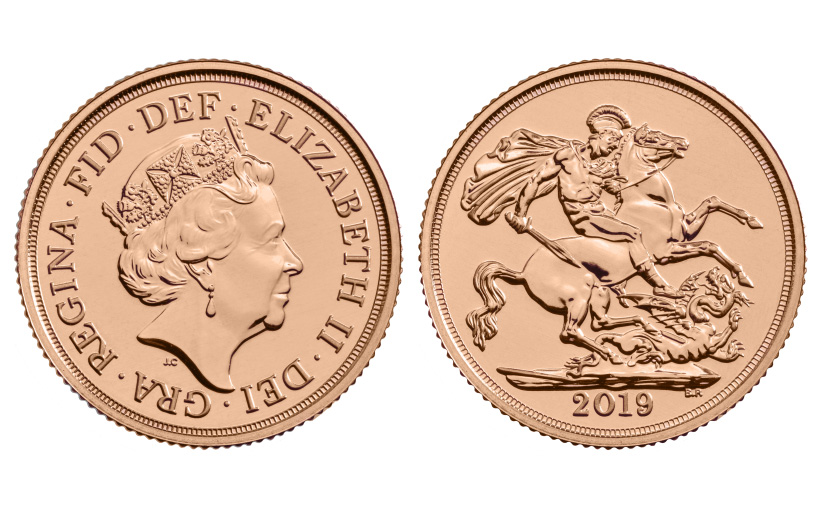
Gold Sovereigns in 2019 A Celebration of Queen & Country
It’s incredibly fitting to consider that Her Majesty Queen Elizabeth II should have been born just two days before St George’s Day. Her actual birthday, on 21st April, will see her turn 92 years old, making her one of the longest-lived monarchs in British history. St George’s Day follows on 23rd April.
The two dates are the perfect time to celebrate the 2019 Gold Sovereign – the newest minted version of the Gold Sovereign. It makes a fitting tribute to Her Majesty’s long-lasting reign – she has remained in place for just over 67 years, exceeding the record-setting rule of her Great-Great Grandmother, Queen Victoria, who ruled for 63 years.
No British monarch has managed to see so many years’ worth of Gold Sovereigns minted with their likeness on them. In celebration, we’re taking a look back at the origins and evolution of these beautiful coins.
Origins of the engraving
St George and the Dragon has been a tale passed down from generation to generation, telling the tale of England’s patron saint, and his slaying of the Dragon. The legend dates back many centuries, and was popularised as an image on the Gold Sovereign by engraver Benedetto Pistrucci in the 19th Century.
Pistrucci’s design continued to be featured on countless Gold Sovereigns during the 20th Century, characterised by the distinctive initials “BP” on each Gold Sovereign.
Tudor origins
British Gold Sovereign coins are steeped in history. Their predecessor, the English Gold Sovereign, was a coin minted during the Tudor dynasty, from 1489 until 1603.
The obverse side didn’t depict St George in this period – instead, these coins depicted the Tudor Rose, the iconic symbol that defined the union of the Houses of Lancaster and York.
Minted in 23-carat (95.83 per cent) gold, it solidified the legacy of the Tudors, who ruled over the English people for over a century.
The Royal connection
The name denotes a firm connection to royalty. The word “sovereign” was derived from the old Latin word for “above”.
The English Gold Sovereign took one of the most precious metals and used it to display a symbol of strength, unity and harmony. Its very name was used to signify the rise of the Tudors, and their intention to outlive all others.
St George appears
After several centuries of absence, Golden Sovereigns underwent a revival from 1817 onwards. To mark the third successive George on the throne, the Gold Sovereign included St George himself, just as he appeared in the legend.
The Gold Sovereign, including the image of St George, has remained a constant image, despite the churn of history, outlasting two world wars, as well as numerous economic storms and periods of strife.
Each Gold Sovereign is now minted at 22-carat, slightly lower in purity, but with far greater details visible. The typical Gold Sovereign weighs 7.98 grams, a weight that has been kept constant, ever since 1817.
Out of circulation
The Gold Sovereign of King George V went out of circulation following the outbreak of World War One, with bank notes becoming more fashionable, but the coins refused to be forgotten.
Gold Sovereigns remain legal tender, and also remain accessible to the general public, as highly collectible items. As was the case with their Tudor predecessors, each Gold Sovereign is minted and is deemed legal tender with a face value of one pound, although its actual value has increased far beyond this in the ensuing centuries as the value of gold has risen.
Victorian variations
As previously mentioned, Queen Victoria herself enjoyed a lengthy reign, much like our current Queen does. Victoria’s longevity resulted in a number of variations of the Gold Sovereign, to reflect some of the greatest milestones during her reign.
Ascending to the throne as a young woman, Queen Victoria was depicted for most of her reign through the Young Head Gold Sovereign, which preserved her likeness from the time of her coronation, well into the late 1880s. Queen Victoria entered old age with a new image minted in her likeness from 1893 onwards, known as the Old Head Gold Sovereign.
The Jubilee Head Gold Sovereign, minted from 1887 to 1893, reflects Victoria’s position as not only Queen but Empress of an empire that spanned much of the globe. The Jubilee Head reflects a zenith of the Victorian era, as well as a unique moment in the history of the British Empire.
The great return
The Gold Sovereign dropped out of circulation by 1914, as Britain entered the First World War. For many years, it seemed as if it had been forgotten. Wars came and went, and Gold Sovereigns had seemingly become a relic of a bygone era.
With time, the Gold Sovereign did return. It did so as a fully-fledged bullion coin in 1957, in the early years of the reign of Queen Elizabeth II.
Despite no longer being in circulation, the Gold Sovereign continued to be minted, albeit in smaller quantities. The earliest of the coins to be minted in Elizabeth II’s reign, between 1957 and 1968, bear the distinction of being her Young Head Gold Sovereigns, marking the pre-decimalisation era of her rule.
Accordingly, the coins minted from the 1970s onwards are marked as Elizabeth’s Decimal Portrait Gold Sovereigns. To celebrate two centuries of minting, the 200th Anniversary Gold Sovereign was produced in 2017, a unique moment in the coin’s history.
Like her ancestors before her, Queen Elizabeth II has seen her likeness engraved onto numerous iterations of the Gold Sovereign since its great return in 1957. The 2019 Gold Sovereign is the latest in a long line, but is still a piece of pure history, something to treasure for years to come – why not consider getting your own 2019 Gold Sovereign from UK Bullion today?

+ There are no comments
Add yours